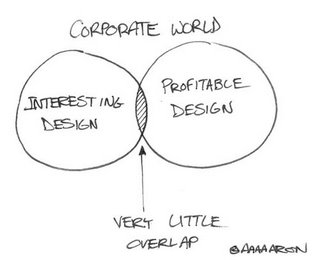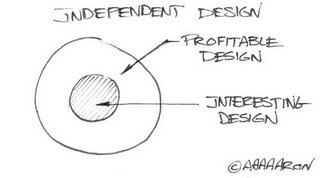Your biggest competition is...Obscurity.But how do you compete with obscurity in a world where the abundance of everything is continually increasing?Radical differentiation barely gets you in the door these days...
A review of The Long Tail by Chris AndersonAfter reading The Long Tail blog for some time now, it was only logical to read and review the book having seen it unfold in real time. The Long Tail is written in an easy to follow style, and advances quickly while still providing the necessary depth needed to fully explain the Long Tail concept. That concept is well-illustrated by a collection of research and observations that the author, and others, have made about the impact of the reduction of distribution costs for nearly all media, but also the democratization of nearly all aspects of bringing a product to market. These two factors are the driving forces behing eBay, Netflix, iTunes and many other digital media distributors and online retail channels - the Long Tail is also responsible for allowing almost anyone to design/manufacture/craft something and sell it to anyone on earth with an internet connection. A multitude of examples, including some that go back well before the digital age, reinforce and explain the theory that niche products will continue to prosper and gain profitability in the future. The unfortunate bit is that the book is being published through decidedly non-Long Tail means - it would have been brilliant had Chris self-published the book to demonstrate the Long Tail first hand - but none the less, The Long Tail appears to be headed towards the realm of the 'hits' where it undoubtedly deserves to be.
The Long Tail @ Amazon
[Full disclosure: I received a pre-release copy of The Long Tail from Chris, but that does not change my feelings on the book].
DIY Furniture + Multiple Price PointsAnother idea I've been throwing around for a while now is how can you effectively make a single item or design appeal to the widest possible audience without removing the highly-focused niche elements? I think the answer may lie in providing the product at a wider range of price points. You see this to some extent now with many manufacturers/retailers - you have a standard/base/stripped-down product at the lowest price point, and then you can add features, customize it, whatever, for an addition to the price. Automobiles are a great example; all models have a 'base' version, with a wide variety of options available - wheel/tire, suspension, graphics, interior, and stereo upgrades just to name a few - often adding many thousands of dollars to the price tag in the end.One thing you don't see the larger companies offering is a kit or DIY version that reduces the price drastically by having the customer add one of the most expensive components of production - labor. This may not work so well for automobiles, but for smaller manufactured items that can be customized (and often are, post sale), it makes a lot of sense.
RTA furniture is one example where the labor cost is reduced (along with the shipping cost!) by having the customer assemble the item. In reality, the product still comes in a limited number of variations (if any). The variations/customization options are the missing key, I think.I want to offer my first products for sale in a multitude of ways, from full component form (lowest possible price, naturally) up to the fully-assembled and finished item, only offered in the specifications that I designed it to be. Customization is endless, but instead of penalizing the customer for personalized changes by adding upcharges, they simply purchase the chair in a less-finished state, for a lower price, and complete it themselves. There are some tradeoffs however - possibly poor construction and finish by the customer, seemingly endless customer support from customers who can't grasp/don't understand how to complete assembly, and possibly negative reviews and public opinion because of this. I maintain my profit margin while spending less time on the product, and the customer ends up with exactly what they want. I have a great deal of confidence in people, and with a little guidance via website, instruction guide, etc., even the most obtuse/clumsy/etc. customers can do the time-consuming-and-high-labor-cost-but-relatively-unskilled finishing and/or assembly component of the process without too much difficulty. Its empowering to build something, especially when you feel like you've "cheated the system" and saved a few bucks, while producing something remarkable.Offering products in such a wide array of finished states is not financially viable to manufacturers who have their profits built around efficiencies of scale, but for a micro manufacturer, it should be a piece of cake. The only added overhead is a bit more info on your website, and maybe a little bit of 'tech support,' which is not such a bad thing (talking with your customers!) provided its not all you end up doing (because your product is impossibly difficult to assemble, for example). This is not a strategy for all products - far from it - but for certain niche products that usually end up with a large price tag because of labor involved (furniture, in this case) I think many customers would opt to buy the "kit" either for the customization/personalization or the cost savings (or both).What do you think?
Open-source furniture?I've been throwing this idea around for a little while: What if furniture was open-source? Not necessarily giving away finished products, but allowing anyone to obtain the 'source code' aka manufacturing drawings? Following the open-source definition for software, you would have to allow anyone to freely redistribute the manufacturing drawings, or sell any copy or derivative of the design provided your name as the originator of the design was clearly indicated. Of course, you would have to have anyone obtaining the manufacturing documentation agree to follow the 'use license' to have any semblence of legal rights, should a company knock you off and flood the market with your designs without giving due credit (although I admit, any legal standing would more than likely be undeniably flimsy).If you are that worried about being knocked out of the market by a knock off being the better product, you are on very shaky ground to begin with. With the internet, and proper documentation, it would be quickly apparent who was cheating the customers, and one hopes that customers have enough respect for designers to purchase the authentic product if they know that knock offs are on the market. For niche-oriented and decidedly non-mass-appeal products, another company is unlikely to mass produce a product that you are selling very small numbers of anyway (and they're likely to fold soon enough, even if this happens). But as a way to help out or inspire another human being that admires your work, why wouldn't you give them an incentive to produce their own copy or (gasp!) make a worthwhile improvement to it? Very few people have access to the tools, raw materials, or well-honed skills that it would take to produce a quality piece of furniture - and those that do probably won't be a potential customer, anyway. If anything, open-sourcing a furniture design is a way to get your product into someone's home when there is no chance of them purchasing it. Although, if your definition of success revolves around amassing large amounts of money through selling a product, its still not going to seem like a good idea...
Projects in development
I've been busy (hence only two posts to date) but I have some projects in the pipeline that should be prototyped sooner or later, and, with any luck, will be available for purchase soon there after.
Be on the look out for a couple of CNC-router oriented chairs, made from plywood. I'm trying to integrate all the grace and balance of archetypal chairs produced from solid wood while drastically reducing the cost of production. Most seating produced from sheet materials is rather awkward, if you haven't noticed.Also, a contemporary, Shaker-inspired chair is in the works. Plans are for it to be adaptable for use indoor, outdoor, wherever you want to sit comfortably. The purpose of these items is mainly to realize some solutions to problems I need solved. I only hope that these pieces can solve problems for others (with or without any customization, which room has been left for, so don't hesitate to request minor changes).Sorry - no images until I've got tangible, physical items (a rendering is useless as a piece of furniture!).Stay tuned!
Interesting Design vs. Profitable DesignI came across the Hackers & Painters essay the other day. Its a great artcle, and a few paragraphs in I was suprised with all of the parallels between 'hackers' and designers with an indie mind-set. One line that really caught my attention was:
The other problem with startups is that there is not much overlap between the kind of software that makes money and the kind that's interesting to write.
Now, change software with furniture design:
The other problem with startups is that there is not much overlap between the kind of [furniture design] that makes money and the kind that's interesting to [design].
This is very true in the corporate world. A design needs to have a certain amount of 'mass appeal' to be viable as a marketable product, according to most in the traditional Furniture Industry. The really interesting stuff gets pushed aside to make way for the tried-and-true and/or watered-down designs, generally.

But what if you apply Long Tail business practices to the world of obscure furniture design? It works for books, music, and DVDs - why not furniture?
It would open up an entirely new world for the independant designer who still relies a great deal on physical retailers to sell product, meaning that you would no longer have to place your wares in the few markets that have a relatively high number of potential buyers. Designers could produce those really off-the-wall pieces, and still be able to find a enough buyers to make it worth their while. This would move all interesting design into the realm of profitable design - i.e. complete overlap.
 There are a lot of unknowns, but I think this will ultimately drive a wave of independent (furniture) design in the near future. I hope to be one of those indie designers riding the wave.
There are a lot of unknowns, but I think this will ultimately drive a wave of independent (furniture) design in the near future. I hope to be one of those indie designers riding the wave.
Of course, all this begs the question - are enough potential customers interested in 'interesting' design to buy the stuff when its more widely available?
A New Beginning
All things must have a beginning, so here we go.
I'll use this space to discuss independent furniture design and the relationship to micro business/micro manufacturing. If you've got something interesting related to the world of furniture design or micro business/manufacturing, shoot me an email or leave a comment.
Stay tuned, there's more after the break...


